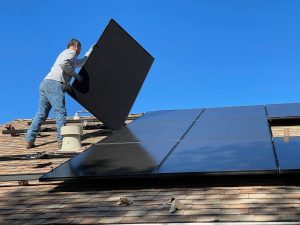Solar Tax Credit 2023: Understanding the Federal Tax Credit
 In 2022, the Federal Government offers compensation for installing solar panels in your home, potentially providing a significant tax break when filing your tax returns this year. The solar tax credit, offered by the U.S. Government, can cover up to 30% of the cost of installing a solar-powered system in your home.
In 2022, the Federal Government offers compensation for installing solar panels in your home, potentially providing a significant tax break when filing your tax returns this year. The solar tax credit, offered by the U.S. Government, can cover up to 30% of the cost of installing a solar-powered system in your home.
What is the Federal Solar Tax Credit?
The Internal Revenue Service (IRS) defines the federal solar tax credit as an investment tax credit (ITC). This incentive aims to encourage investment in products and services that the government supports. In 2022, President Joe Biden signed the Inflation Reduction Act, extending solar tax credits through 2034 as part of the U.S. Government's efforts to reduce the global carbon footprint.
The tax credit, officially known as the residential clean energy credit, isn't limited to solar power. It can cover expenses like equipment and installation but doesn't apply to structural work supporting panels. In some cases, the solar tax credit can be combined with state incentives and utility-funded programs promoting clean energy.
How Does the Solar Tax Credit Function?
The solar tax credit amount depends on the total expenditure on a completed project. It applies to homeowners who install a qualifying system between 2017 and 2034. For 2022, the IRS states that the solar tax credit is 30% for taxpayers filing in 2023. With this credit, savings on an average solar installation can reach $7,500. The 30% rate remains in effect until 2032, decreasing twice in the subsequent two years, eventually reaching 22%. It's important to note that the solar tax credit doesn't provide cash back but significantly reduces energy expenses.
After Filing Your Taxes: Common Questions and Answers
Once you've filed your tax return, you may have some questions. This guide covers common post-filing topics, including refund status, record-keeping, change of address, and amending your return.

Checking Your Refund Status
You can track your refund's progress on the IRS Where's My Refund webpage after your return is accepted. E-filed returns may take up to 72 hours for information to appear, while paper-filed returns can take 3 to 4 weeks. The page updates once daily. To check, have your filing status, the primary SSN, and the exact whole-dollar refund amount ready. If you owe the IRS, enter $1 as the refund amount.
Alternatively, call the IRS Refund Hotline at 1-800-829-1954 for automated refund information, available 24/7.
Maintaining Tax Records
Keep tax records for at least three years from the filing date. Some documents, like those related to home transactions, stock trades, IRAs, or business/rental properties, should be kept longer for personal use and future tax filings.

Address Changes
If your address changes after filing, submit IRS Form 8822, Change of Address. If awaiting a mailed refund, also file an address change with the U.S. Postal Service to forward the check to the correct address.
Correcting Errors and Amending Returns
If you find a mistake on your e-filed or paper return after it has been accepted or mailed, wait for your refund before taking action. The IRS may catch and correct simple errors or omissions, adjusting your refund as needed. If they do, there's no need to file an amended return. To fix errors or add forms (W-2, 1099, etc.) after receiving your refund, file IRS Form 1040X, Amended U.S. Individual Income Tax Return.
For more information contact us at (207) 888-8800.
